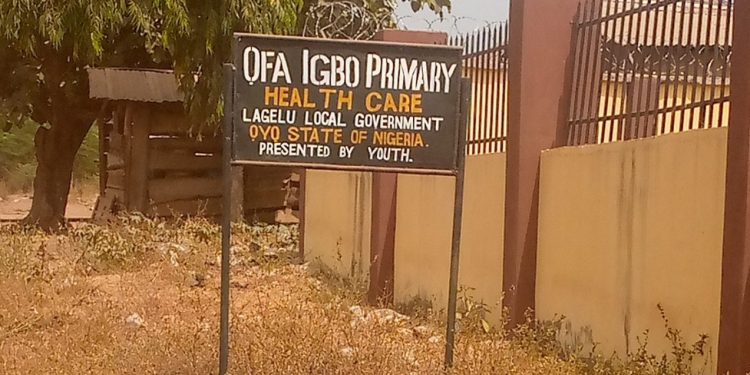On a hot afternoon, Taiwo and Kehinde Isiaq sat outside their house to beat the heat from their apartment.
They sat alongside their father, who was also enjoying the breeze as the heat inside, they said, was unbearable, and electricity was a dream for them in the community.
Since Taiwo and Kehinde were born seven years ago, they have never set their eyes on electricity in Iyana Offa, a community suburb in the Lagelu local government area of Oyo state.
The twins said they only heard from their friends at school that the popular word, “UP NEPA” brings joy and excitement for people who have long seen electricity, but for them, it’s only a wish they hope will come through someday.
Taiwo and Kenny’s residence is about a fifteen-minute drive to Offa Primary Health Center, serving Iyana Offa, Offa Igbo and its host communities.
These twins are just a few of the children delivered at Offa primary health care centre in the community, which do not have access to a direct electricity supply from the grid.
The presence of transformers, wires and poles from Iyana Offa to Offa Igbo for a first-time visitor in the community paints a picture of a constant power supply in the area, but this is different.
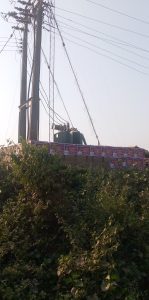
Visits to the PHC in Offa Igbo show that the electricity supply is unavailable though the PHC is under renovation.
Adewale Ayoade, a resident in the community, said the PHCs suffer the same thing as the community, as light has not been available for over five years.
“Since I have been here in this community for over five years, I had never set my eyes on the light at the health centre except for recently when the renovation started, and they were given a generator to work with, and you know all these generators there are limits to what they can do,” Ayoade said.
According to a joint report on health and energy by the World Health Organization (WHO) and World Bank, close to one billion people in low-income communities lack access to healthcare facilities with reliable electricity.
WHO says one-eighth of the global population is in danger of not being able to access the right care they need due to a lack of energy.
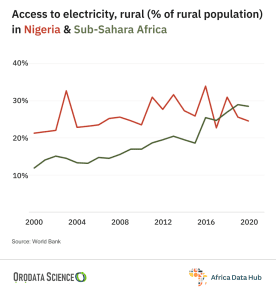
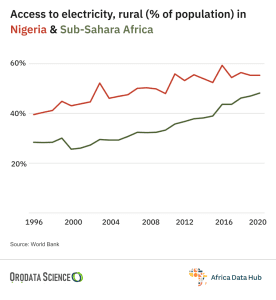
Also without electricity located under the same local government in Iyana Offa is Ejioku and Lalupon PHC. This PHC suffers the same fate as its counterparts in Iyana Offa and Igbo.
During a visit to the centre, it was gathered that the PHC had not used electricity for up to two years as they’ve been disconnected from the grid.
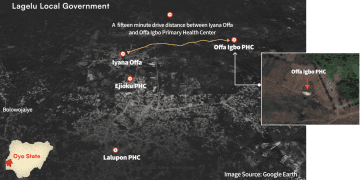
PHCs operating in an unconducive atmosphere
The nurses at Ejioku PHC had just taken delivery of a baby. They were out wiping the sweaty body as the delivery had taken longer than expected. This would have been made easier if a stable power supply had been connected to the centre.
Findings show that the centre does not have a metre to connect electricity to the wards and make work easier for the workers at the centre.
Though residents in this community say, the light is unstable and unreliable, according to them, “they flash it once in a while.”
To power the centre, the health care workers it was gathered only relied on its faulty generator, which was met in poor condition and solar.
“You see, the PHC does not have a metre; there is no how the PHC could benefit from the power supply even when it is available.”
The PHC, it was learnt, last saw electricity from the IBEDC about two years ago.
A resident in the community who identified herself as Mama Ayo said since she has been attending the centre for the past year, she has yet to sight electricity at the centre.
“I have never seen them put on a NEPA light. Moreso, you see this community, we do not even enjoy adequate power; how then do you expect the clinics to have electricity to do their work and provide adequate health care when we only get to see the light once in a while,” Mama Ayo added.
A worker at the centre (name withheld) said they use solar as the centre last saw electricity in about two years.
He said, “the centre uses solar light as there’s no NEPA light. Electricity didn’t enter the PHC, and we don’t even have a metre. And maybe the connection is faulty.”
The worker noted that though they’re aware the community was without electricity for close to a year until when it was restored a bit in December 2022, the centre has to rely on solar power.
“Initially, around 2020, when the light was coming once in a while, it used to last, but between 2021 and 2022, it was total blackout and darkness for us at the PHC, and it was very poor.
“Though we have a solar freezer to keep our vaccine intact, we have a non-functioning generator, not working at all and not in good condition.”
Lamenting, the worker said that with the absence of electricity at the centre, it is always a challenge for staff to charge their phones to access correct health information and give quality health services.
“There are so many things the staff would want to do for the patients, but because there is no light at the PHCs, they couldn’t do it for them.
“Sometimes they wish to play videos for pregnant women and children on how to care for themselves. Give them lectures, but they can only do some of this. This place is a rural area, and the need for more electricity here continues to prevent development.
Also, at Lalupon PHC, the centre it was gathered has been without electricity for seven years.
Resort to alternatives
While grid energy electricity is absent in all the PHCs visited, the centres are now resorting to other forms of energy to keep up their health care delivery.
Lalupon PHC, though without electricity supply from IBEDC could be seen working well with other alternative power supply sources. The centre relies on a heavy noise fuel generator to power the centre.
“Since 2017, this centre has been without electricity. But now the generator and solar power have come to our rescue.”
In Offa Igbo PHC, there is the presence of a generator at the centre, while Ejioku PHC has also resorted to solar energy as the generator is not in good condition.
Electricity and its impact on health care delivery
Energy expert Samuel Olowosejeje said healthcare facilities are prone to limited energy, especially in rural areas.
Olowosejeje noted that lack of electricity would continue to cripple communication and ICT services some centres ought to run.
He also identified that the operations at PHCs would be affected, and the typical day-to-day operation of cooling systems and other sensitive medical equipment.
The expert said if the health care centres continue to depend on generators at all times for their service, it heightens the risk of carbon monoxide and the pollution of the environment.
Communities are helpless and cry for help
Residents of Iyana Offa, a rural area, are among the 92 million Nigerians out of 200 million without electricity, according to the energy progress report 2022.
Also, the 2021 global measurement says Nigeria has the world’s most prominent energy access deficit. Despite the massive spending of 1.6 trillion in electricity in five years, these communities continue to suffer from a lack of electricity supply.
Residents in the communities in Iyana Offa lamented they were tired of the power outage.
A business owner in Iyana Offa, stated the lack of electricity is not only a challenge to health care in the community but a major problem for everyone, most especially for business owners who require electricity.
She said her business suffers as well as others who have one company or the other that requires electricity in the community.
Also speaking, the Vice Chairman of LCDA at Iyana Offa, Pastor Andrew Iduh said that the community once had a transformer issue; thereafter, a new transformer was presented to them by a good Samaritan, yet the issue wasn’t resolved.
Iduh shared all the efforts that have been taken to address the problem but yet to yield efforts, stressing that, “we’ve been to all the NEPA offices around, from the headquarter at Ring road to Ojo to Felele and Alabebe, it has just been promise upon promise; at a time, they came and said there was a problem with trees affecting the poles. We have cut the trees since then, but nothing.
“All our electronic equipment has gotten wasted, some of them rotten. The present chairman of the local government has also made several efforts but has yet to make any progress.
For good seven years, we have been in darkness, and most people have relocated from this community due to the situation,” he added.
The LCDA Chairman thereafter appealed to the state government and concerned authorities “to come to our rescue from this darkness”.
Also, the financial secretary of the Association, Muftau Oyadeji said despite the several steps they’ve taken, the community is stil unable to access electricity.
“The electricity situation here is pathetic; we’re suffering. This is the headquarters of Lagelu, yet we’re living in darkness,” Oyadeji added.
Also, a resident in Ejioku, lamented the unstable power situation in the community, saying that everyone living in the community spends money to charge their mobile phones on a daily basis, and called on the IBEDC to come to their aid.
However, as of the time of filing this report, IBEDC and OYO State ministry of energy are yet to respond on the status of electricity supply in the state.
This report is produced with support from the African Data Hub.

